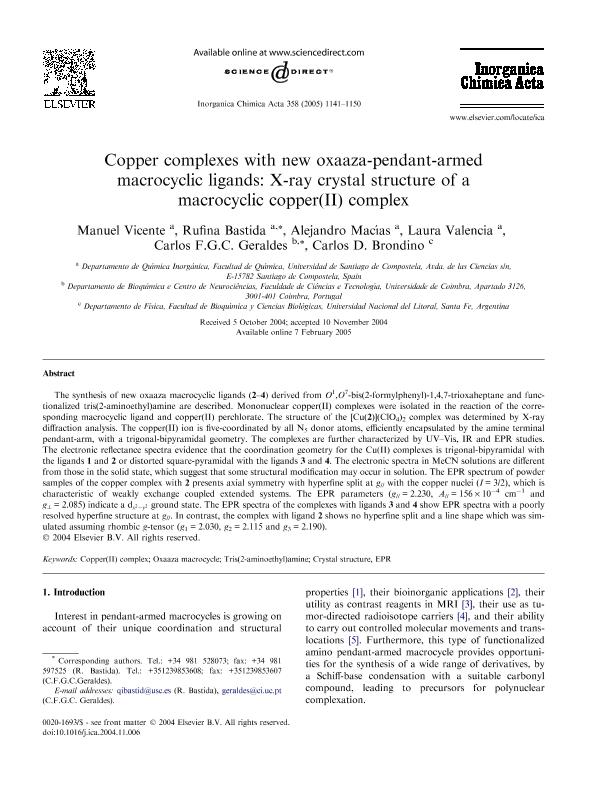Mostrar el registro sencillo del ítem
dc.contributor.author
Vicente, Manuel
dc.contributor.author
Bastida, Rufina
dc.contributor.author
Macías, Alejandro
dc.contributor.author
Valencia, Laura
dc.contributor.author
Geraldes, Carlos F.G.C.
dc.contributor.author
Brondino, Carlos Dante

dc.date.available
2020-04-14T20:35:04Z
dc.date.issued
2005-03
dc.identifier.citation
Vicente, Manuel; Bastida, Rufina; Macías, Alejandro; Valencia, Laura; Geraldes, Carlos F.G.C.; et al.; Copper complexes with new oxaaza-pendant-armed macrocyclic ligands: X-ray crystal structure of a macrocyclic copper(II) complex; Elsevier Science Sa; Inorganica Chimica Acta; 358; 4; 3-2005; 1141-1150
dc.identifier.issn
0020-1693
dc.identifier.uri
http://hdl.handle.net/11336/102554
dc.description.abstract
The synthesis of new oxaaza macrocyclic ligands (2–4) derived from O1,O7-bis(2-formylphenyl)-1,4,7-trioxaheptane and functionalized tris(2-aminoethyl)amine are described. Mononuclear copper(II) complexes were isolated in the reaction of the correspondingmacrocyclic ligand and copper(II) perchlorate. The structure of the [Cu(2)](ClO4)2 complex was determined by X-ray diffraction analysis. The copper(II) ion is five-coordinated by all N5 donor atoms, efficiently encapsulated by the amine terminal pendant-arm, with a trigonal-bipyramidal geometry. The complexes are further characterized by UV–Vis, IR and EPR studies. The electronic reflectance spectra evidence that the coordination geometry for the Cu(II) complexes is trigonal-bipyramidal with the ligands 1 and 2 or distorted square-pyramidal with the ligands 3 and 4. The electronic spectra in MeCN solutions are different from those in the solid state, which suggest that some structural modification may occur in solution. The EPR spectrum of powder samples of the copper complex with 2 presents axial symmetry with hyperfine split at g// with the copper nuclei (I = 3/2), which is characteristic of weakly exchange coupled extended systems. The EPR parameters (g// = 2.230, A// = 156 · 104 cm1 and g^ = 2.085) indicate a dx2-y2 ground state. The EPR spectra of the complexes with ligands 3 and 4 show EPR spectra with a poorly resolved hyperfine structure at g//. In contrast, the complex with ligand 2 shows no hyperfine split and a line shape which was simulated assuming rhombic g-tensor (g1 = 2.030, g2 = 2.115 and g3 = 2.190).
dc.format
application/pdf
dc.language.iso
eng
dc.publisher
Elsevier Science Sa

dc.rights
info:eu-repo/semantics/openAccess
dc.rights.uri
https://creativecommons.org/licenses/by-nc-sa/2.5/ar/
dc.subject.classification
Físico-Química, Ciencia de los Polímeros, Electroquímica

dc.subject.classification
Ciencias Químicas

dc.subject.classification
CIENCIAS NATURALES Y EXACTAS

dc.title
Copper complexes with new oxaaza-pendant-armed macrocyclic ligands: X-ray crystal structure of a macrocyclic copper(II) complex
dc.type
info:eu-repo/semantics/article
dc.type
info:ar-repo/semantics/artículo
dc.type
info:eu-repo/semantics/publishedVersion
dc.date.updated
2020-04-13T13:18:06Z
dc.journal.volume
358
dc.journal.number
4
dc.journal.pagination
1141-1150
dc.journal.pais
Países Bajos

dc.journal.ciudad
Amsterdam
dc.description.fil
Fil: Vicente, Manuel. Universidad de Santiago de Compostela; España
dc.description.fil
Fil: Bastida, Rufina. Universidad de Santiago de Compostela; España
dc.description.fil
Fil: Macías, Alejandro. Universidad de Santiago de Compostela; España
dc.description.fil
Fil: Valencia, Laura. Universidad de Santiago de Compostela; España
dc.description.fil
Fil: Geraldes, Carlos F.G.C.. Universidad de Santiago de Compostela; España
dc.description.fil
Fil: Brondino, Carlos Dante. Universidad Nacional del Litoral; Argentina
dc.journal.title
Inorganica Chimica Acta

dc.relation.alternativeid
info:eu-repo/semantics/altIdentifier/doi/http://dx.doi.org/10.1016/j.ica.2004.11.006
Archivos asociados
